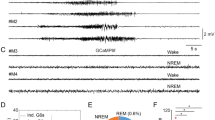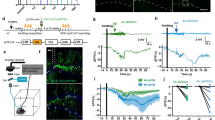Abstract
Microgyria is associated with epilepsy and due to developmental disruption of neuronal migration. However, the role of endogenous subventricular zone-derived neural progenitors (SDNPs) in formation and hyperexcitability has not been fully elucidated. Here, we establish a neonatal cortex freeze-lesion (FL) model, which was considered as a model for focal microgyria, and simultaneously label SDNPs by CM-DiI. Morphological investigation showed that SDNPs migrated into FL and differentiated into neuronal and glia cell types, suggesting the involvement of endogenous SDNPs in the formation of FL-induced microgyria. Patch-clamp recordings in CM-DiI positive (CM-DiI+) pyramidal neurons within FL indicated an increase in frequency of spontaneous action potentials, while the resting membrane potential did not differ from the controls. We also found that spontaneous excitatory postsynaptic currents (EPSCs) increased in frequency but not in amplitude compared with controls. The evoked EPSCs showed a significant increase of 10–90 % in rise time and decay time in the CM-DiI+ neurons. Moreover, paired-pulse facilitation was dramatically larger in CM-DiI+ pyramidal neurons. Western blotting data showed that AMPA and NMDA receptors were increased to some extent in the FL cortex compared with controls, and the NMDA/AMPA ratio of eEPSCs at CM-DiI+ pyramidal neurons was significantly increased. Taken together, our findings provide novel evidence for the contribution of endogenous SDNPs in the formation and epileptogenicity of FL-induced focal microgyria.







Similar content being viewed by others
References
Andre VM, Wu N, Yamazaki I, Nguyen ST, Fisher RS, Vinters HV, Mathern GW, Levine MS, Cepeda C (2007) Cytomegalic interneurons: A new abnormal cell type in severe pediatric cortical dysplasia. J Neuropathol Exp Neurol 66:491–504
Brill J, Huguenard JR (2010) Enhanced infragranular and supragranular synaptic input onto layer 5 pyramidal neurons in a rat model of cortical dysplasia. Cereb Cortex 20(12):2926–2938
Campbell SL, Hablitz JJ (2008) Decreased glutamate transport enhances excitability in a rat model of cortical dysplasia. Neurobiol Dis 32:254–61
Charvet CJ, Striedter GF (2011) Causes and consequences of expanded subventricular zones. Eur J Neurosci 34:988–93
Chu Y, Parada I, Prince DA (2009) Temporal and topographic alterations in expression of the alpha3 isoform of Na+, K(+)-ATPase in the rat freeze lesion model of microgyria and epileptogenesis. Neuroscience 162:339–48
Curtis MA, Kam M, Faull RL (2011) Neurogenesis in humans. Eur J Neurosci 33:1170–4
DeFazio RA, Hablitz JJ (2000) Alterations in NMDA receptors in a rat model of cortical dysplasia. J Neurophysiol 83:315–21
Dell'Albani P (2008) Stem cell markers in gliomas. Neurochem Res 33:2407–15
Dvorak K, Feit J, Jurankova Z (1978) Experimentally induced focal microgyria and status verrucosus deformis in rats—pathogenesis and interrelation. Histological and autoradiographical study. Acta Neuropathol 44:121–9
Greenwood JS, Wang Y, Estrada RC, Ackerman L, Ohara PT, Baraban SC (2009) Seizures, enhanced excitation, and increased vesicle number in Lis1 mutant mice. Ann Neurol 66:644–53
Guerrini R, Dobyns WB, Barkovich AJ (2008) Abnormal development of the human cerebral cortex: Genetics, functional consequences and treatment options. Trends Neurosci 31:154–62
Guerrini R, Parrini E (2009) Neuronal migration disorders. Neurobiol Dis 38:154–66
Hemmrich K, Meersch M, von Heimburg D, Pallua N (2006) Applicability of the dyes CFSE, CM-DiI and PKH26 for tracking of human preadipocytes to evaluate adipose tissue engineering. Cells Tissues Organs 184:117–27
Jacobs KM, Gutnick MJ, Prince DA (1996) Hyperexcitability in a model of cortical maldevelopment. Cereb Cortex 6:514–23
Jacobs KM, Hwang BJ, Prince DA (1999) Focal epileptogenesis in a rat model of polymicrogyria. J Neurophysiol 81:159–73
Jacobs KM, Prince DA (2005) Excitatory and inhibitory postsynaptic currents in a rat model of epileptogenic microgyria. J Neurophysiol 93:687–96
Jiao Q, Zhang HX, Lv HX, Liu Y, Li JL (2011) Organotypic slice culture of neonatal rat cortex and induced neural stem cell differentiation. Nan Fang Yi Ke Da Xue Xue Bao 31:1318–22
Kaneko N, Sawamoto K (2009) Adult neurogenesis and its alteration under pathological conditions. Neurosci Res 63:155–64
Kellinghaus C, Moddel G, Shigeto H, Ying Z, Jacobsson B, Gonzalez-Martinez J, Burrier C, Janigro D, Najm IM (2007) Dissociation between in vitro and in vivo epileptogenicity in a rat model of cortical dysplasia. Epileptic Disord 9:11–9
Liu JS (2011) Molecular genetics of neuronal migration disorders. Curr Neurol Neurosci Rep 11:171–8
Luhmann HJ, Raabe K (1996) Characterization of neuronal migration disorders in neocortical structures: I. Expression of epileptiform activity in an animal model. Epilepsy Res 26:67–74
Luhmann HJ, Karpuk N, Qu M, Zilles K (1998) Characterization of neuronal migration disorders in neocortical structures. II. Intracellular in vitro recordings. J Neurophysiol 80:92–102
Migaud M, Batailler M, Segura S, Duittoz A, Franceschini I, Pillon D (2010) Emerging new sites for adult neurogenesis in the mammalian brain: A comparative study between the hypothalamus and the classical neurogenic zones. Eur J Neurosci 32:2042–52
Peters O, Redecker C, Hagemann G, Bruehl C, Luhmann HJ, Witte OW (2004) Impaired synaptic plasticity in the surround of perinatally acquired [correction of aquired] dysplasia in rat cerebral cortex. Cereb Cortex 14:1081–7
Quinones-Hinojosa A, Chaichana K (2007) The human subventricular zone: A source of new cells and a potential source of brain tumors. Exp Neurol 205:313–24
Raybaud C, Widjaja E (2011) Development and dysgenesis of the cerebral cortex: Malformations of cortical development. Neuroimaging Clin N Am 21:483–543, vii
Rosen GD, Press DM, Sherman GF, Galaburda AM (1992) The development of induced cerebrocortical microgyria in the rat. J Neuropathol Exp Neurol 51:601–11
Rosen GD, Sherman GF, Galaburda AM (1994) Radial glia in the neocortex of adult rats: Effects of neonatal brain injury. Brain Res Dev Brain Res 82:127–35
Rosen GD, Waters NS, Galaburda AM, Denenberg VH (1995) Behavioral consequences of neonatal injury of the neocortex. Brain Res 681:177–89
Rosen GD, Sherman GF, Galaburda AM (1996) Birthdates of neurons in induced microgyria. Brain Res 727:71–8
Rosen GD, Burstein D, Galaburda AM (2000) Changes in efferent and afferent connectivity in rats with induced cerebrocortical microgyria. J Comp Neurol 418:423–40
Rowland NC, Englot DJ, Cage TA, Sughrue ME, Barbaro NM, Chang EF (2012) A meta-analysis of predictors of seizure freedom in the surgical management of focal cortical dysplasia. J Neurosurg 116:1035–41
Sawai C, Takano T, Takeuchi Y (2009) Experimental neuronal migration disorders following the administration of ibotenate in hamsters: The role of the subventricular zone in the development of cortical dysplasia. J Child Neurol 24:275–86
Scantlebury MH, Ouellet PL, Psarropoulou C, Carmant L (2004) Freeze lesion-induced focal cortical dysplasia predisposes to atypical hyperthermic seizures in the immature rat. Epilepsia 45:592–600
Shu HF, Zhang CQ, Yin Q, An N, Liu SY, Yang H (2010) Expression of the interleukin 6 system in cortical lesions from patients with tuberous sclerosis complex and focal cortical dysplasia type IIb. J Neuropathol Exp Neurol 69:838–49
Takano T (2011) Seizure susceptibility in polymicrogyria: Clinical and experimental approaches. Epilepsy Res 96:1–10
Vandenbosch R, Borgs L, Beukelaers P, Belachew S, Moonen G, Nguyen L, Malgrange B (2009) Adult neurogenesis and the diseased brain. Curr Med Chem 16:652–66
Acknowledgments
We would like to thank Prof. Zhuan Zhou (Institute of Molecular Medicine, Peking University, China) for his technical assistance in the electrophysiological study. This work was supported by the National Natural Science Foundation of China (Nos. 81100975 and 81371430), Natural Science Foundation Project of CQ CSTC (No. 2011JJ0124), China Postdoctoral Science Foundation (No. 2012 T50850), Research Foundation of General Hospital of Chengdu Military Region (No. 424121H3), and Science Foundation of Health Office of Sichuan Province (No. 42412D16).
Conflict of Interests
The authors declare no conflict of interest.
Author information
Authors and Affiliations
Corresponding author
Additional information
Hai-Feng Shu and Yong-Qin Kuang contributed equally to this work.
Electronic supplementary material
Below is the link to the electronic supplementary material.
ESM 1
(DOC 39 kb)
Supplementary Figure 1
Examples of hematoxylin and eosin (H&E)-stained sections from (a) P10 and (b) P30 DiI-FL rats. Note the infolded I-III cortical layers comprising the microgyrus (black arrow) and the microsulcus. (JPEG 14 kb)
Supplementary Figure 2
( a-c ) Immunohistochemical co-localization of CM-DiI positive cells with SYN. Arrows show double-positive cells for CM-DiI and SYN. Scale bars: 20 μm. ( d - e ) Representative electron micrographs showing the synaptic connection (red arrow) in CM-DiI positive cells. ( f ) Representative traces of spontaneous EPSCs recorded from a CM-DiI positive cell of P30 DiI-FL cortex. sEPSCs were abolished by application of CNQX and APV (bottom trace). (JPEG 19 kb)
Rights and permissions
About this article
Cite this article
Shu, HF., Kuang, YQ., Liu, SY. et al. Endogenous Subventricular Zone Neural Progenitors Contribute to the Formation and Hyperexcitability of Experimental Model of Focal Microgyria. J Mol Neurosci 52, 586–597 (2014). https://doi.org/10.1007/s12031-013-0114-5
Received:
Accepted:
Published:
Issue Date:
DOI: https://doi.org/10.1007/s12031-013-0114-5




